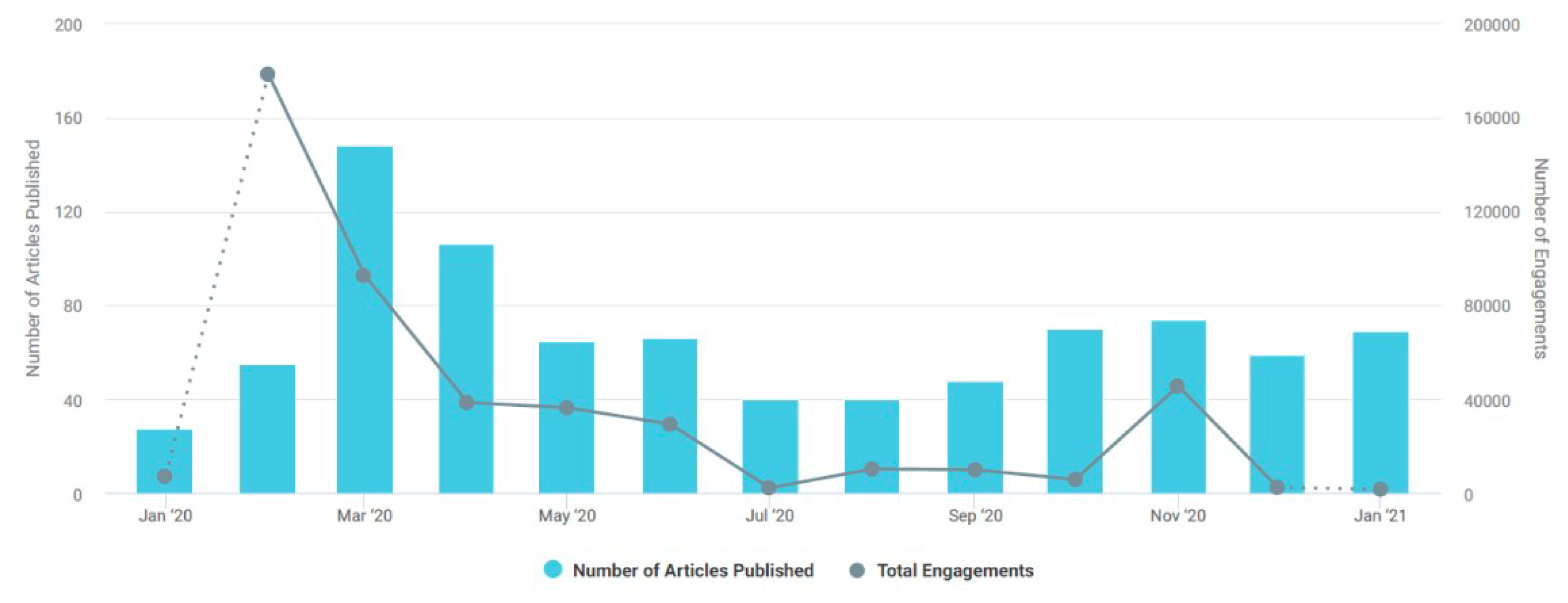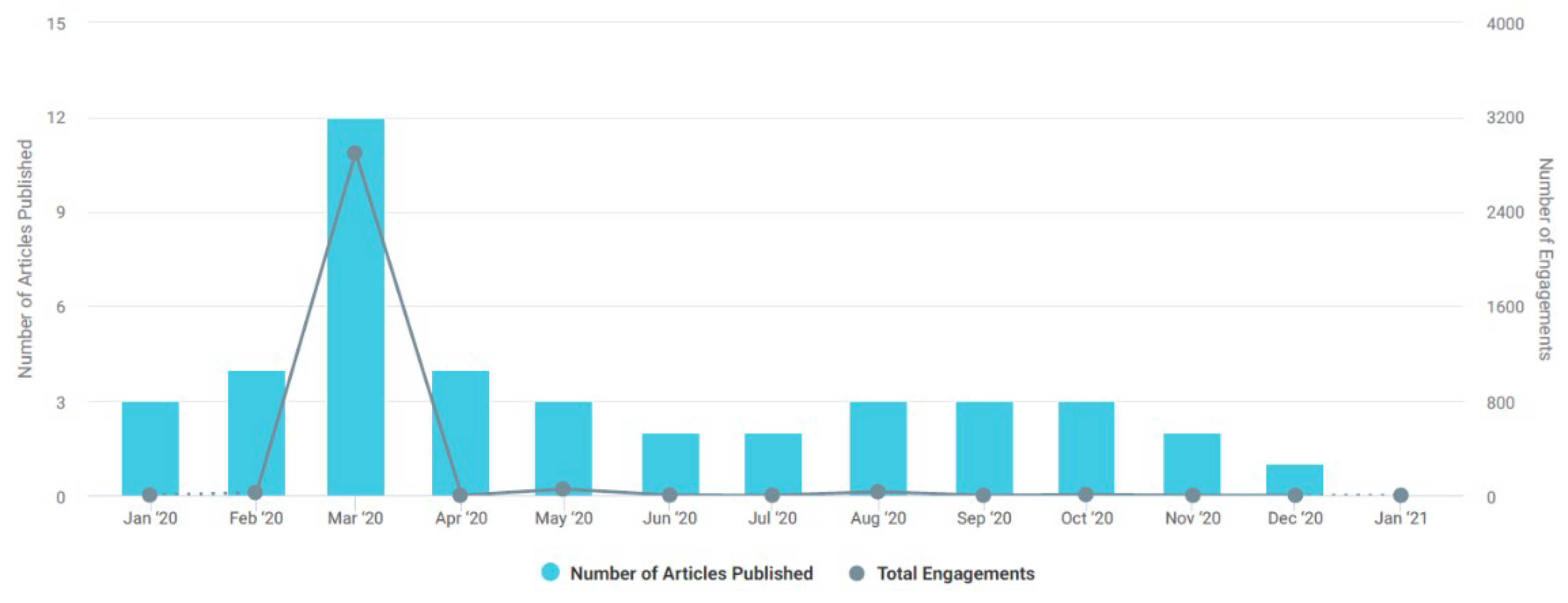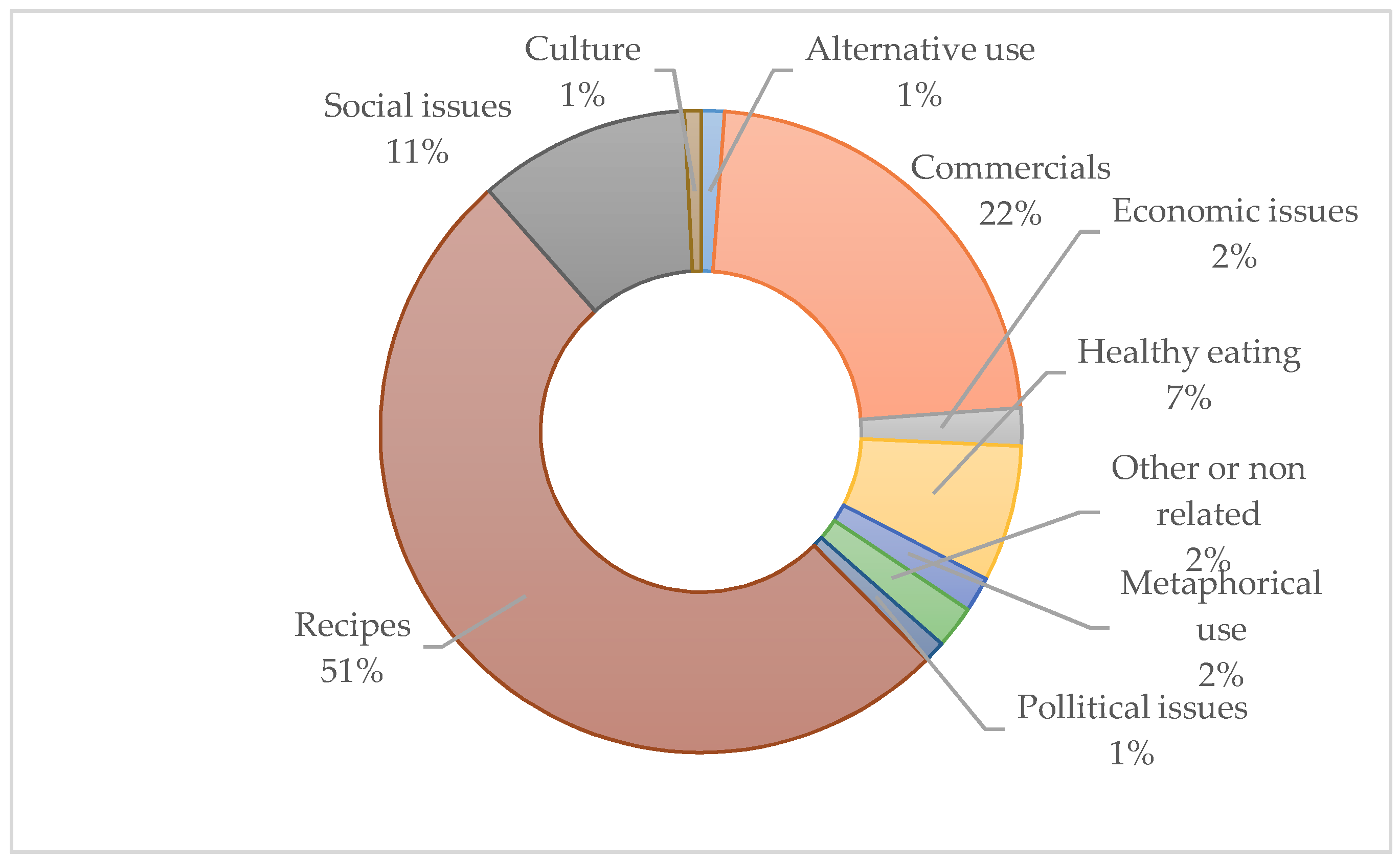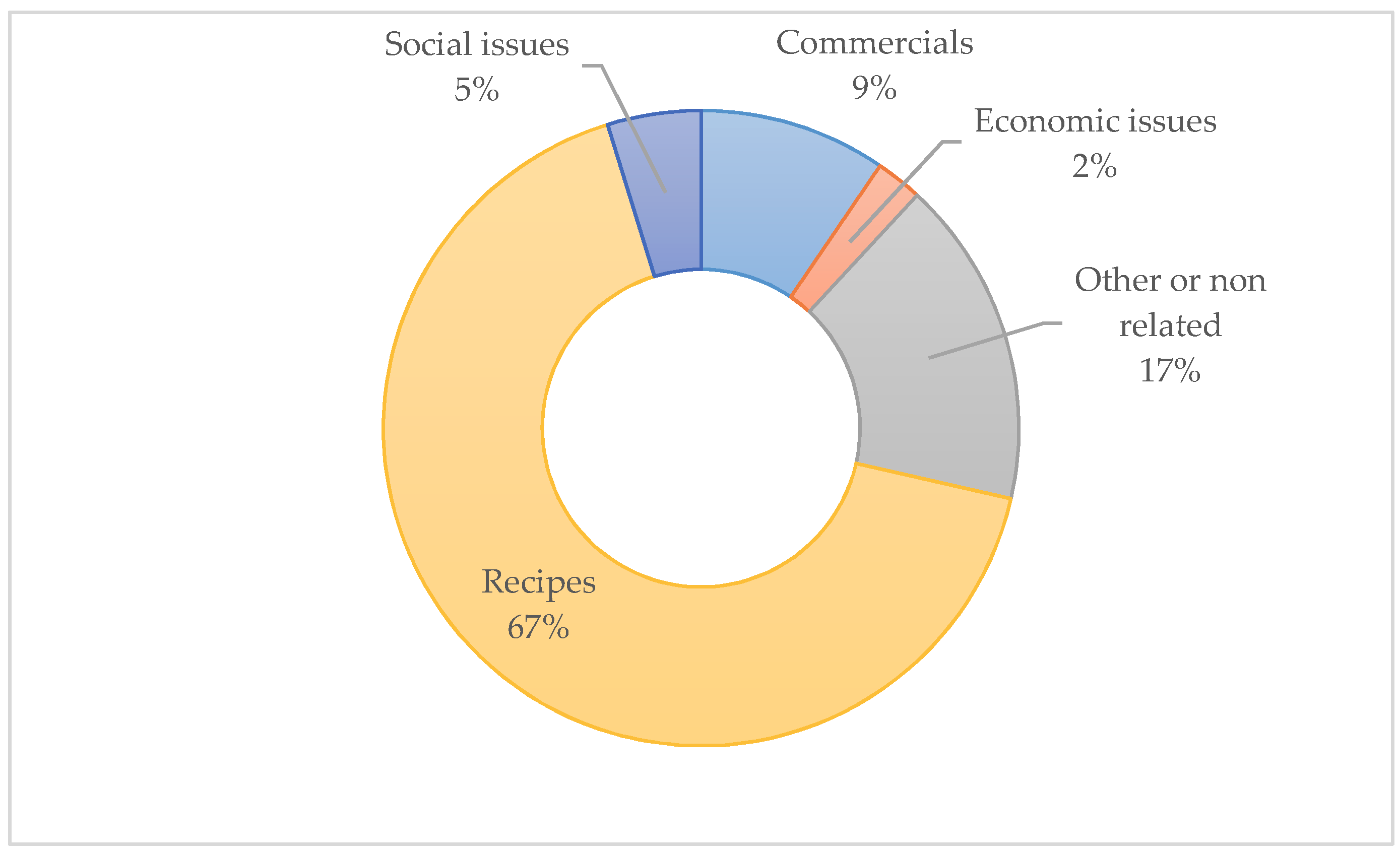Influencing Factors and Social Media Reflections of Bakery Products Consumption in Romania
Abstract
1. Introduction
- Determining the importance given to bakery products as a topic of discussion at the social media level in Romania through a qualitative analysis; and
- Determining consumer preferences for bakery products and the main factors that influence the choice of these products through a quantitative analysis.
2. Theoretical Background
3. Methodology
4. Findings and Discussion
4.1. Engagement with Media Posts Regarding Bakery Products
4.2. Influencing Factors of Bakery Product Consumption
5. Conclusions, Implications, and Limitations
Author Contributions
Funding
Institutional Review Board Statement
Informed Consent Statement
Data Availability Statement
Acknowledgments
Conflicts of Interest
References
- Awika, J.M. Major cereal grains production and use around the world. In Advances in Cereal Science: Implications to Food Processing and Health Promotion; ACS Symposium Series; American Chemical Society: Washington, DC, USA, 2011; Volume 1089, Chapter 1; pp. 1–13. [Google Scholar] [CrossRef]
- Shewry, P.R.; Hey, S.J. The contribution of wheat to human diet and health. Food Energy Secur. 2015, 4, 178–202. [Google Scholar] [CrossRef]
- Yiridoe, E.K.; Bonti-Ankomah, S.; Martin, R.C. Comparison of consumer perceptions and preference toward organic versus conventionally produced foods: A review and update of the literature. Renew. Agric. Food Syst. 2005, 193–205. [Google Scholar] [CrossRef]
- Harari, Y.N. Sapiens: A Brief History of Humankind. In History Biggest Fraud; Random House: New York, NY, USA, 2014. [Google Scholar]
- Shan, L.; Molberg, Ø.; Parrot, I.; Hausch, F.; Filiz, F.; Gray, G.M.; Sollid, L.M.; Khosla, C. Structural basis for gluten intolerance in celiac sprue. Science 2002, 297, 2275–2279. [Google Scholar] [CrossRef]
- Newby, P.K.; Maras, J.; Bakun, P.; Muller, D.; Ferrucci, L.; Tucker, K.L. Intake of whole grains, refined grains, and cereal fiber measured with 7-d diet records and associations with risk factors for chronic disease. Am. J. Clin. Nutr. 2007, 86, 1745–1753. [Google Scholar] [CrossRef]
- Food and Agriculture Organization (FAO). New Food Balance. 2021. Available online: http://www.fao.org/faostat/en/#data/FBS (accessed on 20 January 2021).
- Kostov, P.; Lingard, J. Subsistence farming in transitional economies: Lessons from Bulgaria. J. Rural Stud. 2002, 18, 83–94. [Google Scholar] [CrossRef]
- National Statistics Institute (NIS). Average Monthly Spending per Household. 2021. Available online: http://statistici.insse.ro:8077/tempo-online/#/pages/tables/insse-table (accessed on 21 January 2021).
- Eurostat. How Much are Households Spending on Food? 2019. Available online: https://ec.europa.eu/eurostat/web/products-eurostat-news/-/DDN-20191209-1?inheritRedirect=true&redirect=%2Feurostat%2Fweb%2Fmain%2Fhome (accessed on 21 January 2021).
- Siddiqui, S.; Singh, T. Social media its impact with positive and negative aspects. Int. J. Comput. Appl. Technol. Res. 2016, 5, 71–75. [Google Scholar] [CrossRef]
- Akram, W.; Kumar, R. A study on positive and negative effects of social media on society. Int. J. Comput. Sci. Eng. 2017, 5, 347–354. [Google Scholar] [CrossRef]
- Corbett, J.B.; Durfee, J.L. Testing public (un) certainty of science: Media representations of global warming. Sci. Commun. 2004, 26, 129–151. [Google Scholar] [CrossRef]
- Filieri, R.; Alguezaui, S.; McLeay, F. Why do travelers trust TripAdvisor? Antecedents of trust towards consumer-generated media and its influence on recommendation adoption and word of mouth. Tour. Manag. 2015, 51, 174–185. [Google Scholar] [CrossRef]
- Liu, Y.; Lopez, R.A. The impact of social media conversations on consumer brand choices. Mark. Lett. 2016, 27, 1–13. [Google Scholar] [CrossRef]
- Igrejas, G.; Branlard, G. The importance of wheat. In Wheat Quality for Improving Processing and Human Health; Springer: Cham, Switzerland, 2020; pp. 1–7. [Google Scholar]
- Tekindal, M.A.; BAYRAK, H.; ÖZKAYA, B.; Yasemin, G.E.N.Ç. Box-Behnken Experimental Design in Factorial Experiments: The Importance of Bread for Nutrition and Health Running Head. Turk. J. Field Crop. 2012, 17, 115–123. [Google Scholar]
- Burton, P.M.; Monro, J.A.; Alvarez, L.; Gallagher, E. Glycemic impact and health: New horizons in white bread formulations. Crit. Rev. Food Sci. Nutr. 2011, 51, 965–982. [Google Scholar] [CrossRef]
- De Boni, A.; Pasqualone, A.; Roma, R.; Acciani, C. Traditions, health and environment as bread purchase drivers: A choice experiment on high-quality artisanal Italian bread. J. Clean. Prod. 2019, 221, 249–260. [Google Scholar] [CrossRef]
- Kiesel, K.; McCluskey, J.; Villas-Boas, S. Nutritional Labeling and Consumer Choices. Annu. Rev. Resour. Econ. 2011, 3, 141–158. [Google Scholar] [CrossRef]
- Caswell, J.A.; Mojduszka, E.M. Using informational labeling to influence the market for quality in food products. Am. J. Agrie. Econ. 1996, 78, 1248–1253. [Google Scholar] [CrossRef]
- Montandon, A.C.; Colli, C. Effective nutrition labels for fast food consumers. Br. Food J. 2016, 118, 2534–2549. [Google Scholar] [CrossRef]
- Sánchez-García, I.; Rodríguez-Insuasti, H.; Martí-Parreño, J.; Sánchez-Mena, A. Nutritional traffic light and self-regulatory consumption: The role of emotions. Br. Food J. 2019, 121, 183–198. [Google Scholar] [CrossRef]
- Fichera, E.; von Hinke, S. The response to nutritional labels: Evidence from a quasi-experiment. J. Health Econ. 2020, 72, 102326. [Google Scholar] [CrossRef]
- Sunstein, C.R. Are food labels good? Food Policy 2020, 99, 101984. [Google Scholar] [CrossRef]
- Worsley, A. The behavioural and demographic contexts of white bread consumption. Br. Food J. 2003, 105, 695–699. [Google Scholar] [CrossRef]
- Gellynck, X.; Kühne, B.; Van Bockstaele, F.; Van de Walle, D.; Dewettinck, K. Consumer perception of bread quality. Appetite 2009, 53, 16–23. [Google Scholar] [CrossRef]
- Sajdakowska, M.; Gębski, J.; Żakowska-Biemans, S.; Jeżewska-Zychowicz, M. Willingness to eat bread with health benefits: Habits, taste and health in bread choice. Public Health 2019, 167, 78–87. [Google Scholar] [CrossRef]
- Dragon, P.; Albergaria, H. (Eds.) Political Argumentary for the Economy of Proximity Development (ANATOLE Project Report). Retrieved from Association of the Agricultural Chambers of the Atlantic Arc Website. 2012. Available online: http://www.ac3a.fr/AC3A_en.php (accessed on 5 February 2021).
- Galanakis, C.M. The food systems in the era of the coronavirus (COVID-19) pandemic crisis. Foods 2020, 9, 523. [Google Scholar] [CrossRef]
- Fernández-Ferrín, P.; Calvo-Turrientes, A.; Bande, B.; Artaraz-Miñón, M.; Galán-Ladero, M.M. The valuation and purchase of food products that combine local, regional and traditional features: The influence of consumer ethnocentrism. Food Qual. Prefer. 2018, 64, 138–147. [Google Scholar] [CrossRef]
- Soukand, R.; Stryamets, N.; Fontefrancesco, M.F.; Pieroni, A. The importance of tolerating interstices: Babushka markets in Ukraine and Eastern Europe and their role in maintaining local food knowledge and diversity. Heliyon 2020, 6, e03222. [Google Scholar] [CrossRef] [PubMed]
- Paustian, M.; Reinecke, F.-E.; Theuvsen, L. Consumer preferences for regional meat products. Br. Food J. 2016, 118, 2761–2780. [Google Scholar] [CrossRef]
- Nacef, M.; Lelièvre-Desmas, M.; Symoneaux, R.; Jombart, L.; Flahaut, C.; Chollet, S. Consumers’ expectation and liking for cheese: Can familiarity effects resulting from regional differences be highlighted within a country? Food Qual. Prefer. 2019, 72, 188–197. [Google Scholar] [CrossRef]
- Chen, X.; Gao, Z.; McFadden, B.R. Reveal preference reversal in consumer preference for sustainable food products. Food Qual. Prefer. 2020, 79, 103754. [Google Scholar] [CrossRef]
- Cvijanović, D.; Ignjatijević, S.; Vapa Tankosić, J.; Cvijanović, V. Do Local Food Products Contribute to Sustainable Economic Development? Sustainability 2020, 12, 2847. [Google Scholar] [CrossRef]
- Frank, B.; Abulaiti, G.; Enkawa, T. Regional differences in consumer preference structures within China. J. Retail. Consum. Serv. 2014, 21, 203–210. [Google Scholar] [CrossRef]
- Bruwer, J.; Saliba, A.; Miller, B. Consumer behaviour and sensory preference differences: Implications for wine product marketing. J. Consum. Mark. 2011, 28, 5–18. [Google Scholar] [CrossRef]
- Teuber, R.; Dolgopolova, I.; Nordström, J. Some like it organic, some like it purple and some like it ancient: Consumer preferences and WTP for value-added attributes in whole grain bread. Food Qual. Prefer. 2016, 52, 244–254. [Google Scholar] [CrossRef]
- Meyerding, S.G.; Kürzdörfer, A.; Gassler, B. Consumer preferences for superfood ingredients—The case of bread in Germany. Sustainability 2018, 10, 4667. [Google Scholar] [CrossRef]
- Jeswani, H.K.; Burkinshaw, R.; Azapagic, A. Environmental sustainability issues in the food-energy-water nexus: Breakfast cereals and snacks. Sustain. Prod. Consum. 2015, 2, 17–28. [Google Scholar] [CrossRef]
- Scardigno, A. New solutions to reduce water and energy consumption in crop production: A water–energy–food nexus perspective. Curr. Opin. Environ. Sci. Health 2020, 13, 11–15. [Google Scholar] [CrossRef]
- Krishnan, R.; Agarwal, R.; Bajada, C.; Arshinder, K. Redesigning a food supply chain for environmental sustainability–An analysis of resource use and recovery. J. Clean. Prod. 2020, 242, 118374. [Google Scholar] [CrossRef]
- Aldaco, R.; Hoehn, D.; Laso, J.; Margallo, M.; Ruiz-Salmón, J.; Cristobal, J.; Kahhat, R.; Villanueva-Rey, P.; Bala, A.; Batlle-Bayer, L.; et al. Food waste management during the COVID-19 outbreak: A holistic climate, economic and nutritional approach. Sci. Total Environ. 2020, 742, 140524. [Google Scholar] [CrossRef]
- Meyers, C.; Abrams, K. Feeding the debate: A qualitative framing analysis of organic food news media coverage. J. Appl. Commun. 2010, 94, 22–37. [Google Scholar] [CrossRef]
- Henderson, J.; Coveney, J.; Ward, P.; Taylor, A. Governing childhood obesity: Framing regulation of fast food advertising in the Australian print media. Soc. Sci. Med. 2009, 69, 1402–1408. [Google Scholar] [CrossRef]
- Vicsek, L. Gene-fouled or gene-improved? Media framing of GM crops and food in Hungary. New Genet. Soc. 2013, 32, 54–77. [Google Scholar] [CrossRef][Green Version]
- Stefanik-Sidener, K. Nature, nurture, or that fast food hamburger: Media framing of diabetes in the New York Times from 2000 to 2010. Health Commun. 2013, 28, 351–358. [Google Scholar] [CrossRef] [PubMed]
- Runge, K.K.; Chung, J.H.; Su, L.Y.F.; Brossard, D.; Scheufele, D.A. Pink slimed: Media framing of novel food technologies and risk related to ground beef and processed foods in the US. Meat Sci. 2018, 143, 242–251. [Google Scholar] [CrossRef] [PubMed]
- Buzzsumo. 2021. Available online: https://buzzsumo.com/ (accessed on 28 January 2021).
- Waszak, P.M.; Kasprzycka-Waszak, W.; Kubanek, A. The spread of medical fake news in social media–the pilot quantitative study. Health Policy Technol. 2018, 7, 115–118. [Google Scholar] [CrossRef]
- John, K. Journals on information literacy: Citation analysis and social impact metrics. Ser. Libr. 2019, 77, 23–37. [Google Scholar] [CrossRef]
- Massarani, L.; Leal, T.; Waltz, I. The debate on vaccines in social networks: An exploratory analysis of links with the heaviest traffic. Cad. De Saúde Pública 2020, 36, e00148319. [Google Scholar] [CrossRef]
- Reed, H.H.P. Framing of Immigrants and Refugees: A Content Analysis of Mainstream and Partisan News Coverage of Immigration. Ph.D. Dissertation, University of Missouri, Columbia, MO, USA, 2017. [Google Scholar]
- He, L.; Han, C.; Mukherjee, A.; Obradovic, Z.; Dragut, E. On the dynamics of user engagement in news comment media. Wiley Interdiscip. Rev. Data Min. Knowl. Discov. 2020, 10, e1342. [Google Scholar] [CrossRef]
- Vaughn, P.; Turner, C. Decoding via coding: Analyzing qualitative text data through thematic coding and survey methodologies. J. Libr. Adm. 2016, 56, 41–51. [Google Scholar] [CrossRef]
- Cappelli, L.; D’ascenzo, F.; Ruggieri, R.; Rossetti, F.; Scalingi, A. The attitude of consumers towards “Made in Italy” products. An empirical analysis among Italian customers. Manag. Mark. Chall. Knowl. Soc. 2019, 14, 31–47. [Google Scholar] [CrossRef]
- Coşkun, A.; Özbük, R.M.Y. What influences consumer food waste behavior in restaurants? An application of the extended theory of planned behavior. Waste Manag. 2020, 117, 170–178. [Google Scholar] [CrossRef]
- Marina, M.; Asma, A.; Jaafar, S.N.A.; Abdul Wahab, M.R.; Wan Zainal Shukri, W.H. Nutrition menu labelling in Terengganu: A cross-sectional study of knowledge, attitudes, perception and their relationship with healthy food choices. Food Res. 2020, 4, 1573–1581. [Google Scholar] [CrossRef]
- Everitt, B.S.; Skrondal, A. The Cambridge Dictionary of Statistics; Cambridge University Press: Cambridge, UK, 2010. [Google Scholar]
- Yamane, T. Statistics: An Introduction Analysis; Harper & Row: NewYork, NY, USA, 1973. [Google Scholar]
- Oluwafemi, I.; Oluwafemi, J.; Laseinde, T.O.; Awoyemi, B.O.; Babatunde, A. Datasheet showing the impact of work environment on productivity in higher education institutions. Data Brief 2019, 25, 104090. [Google Scholar] [CrossRef] [PubMed]
- Mishra, D.; Min, J. Analyzing the relationship between dependent and independent variables in marketing: A comparison of multiple regression with path analysis. Innov. Mark. 2010, 6, 2259524. [Google Scholar] [CrossRef]
- Herbst, K.; Becker, G.M.A.; Harper, L.; Bagley, D.; Nieuwhof-Leppink, A.J.; Kaefer, M.; Kalfa, N. Don’t be mean, be above average: Understanding data distribution and descriptive statistics. J. Pediatric Urol. 2020, 16, 712. [Google Scholar] [CrossRef] [PubMed]
- McHugh, M.L. The chi-square test of independence. Biochem. Med. 2013, 23, 143–149. [Google Scholar] [CrossRef] [PubMed]
- Paul, K.I.; Batinic, B. The need for work: Jahoda’s latent functions of employment in a representative sample of the German population. J. Organ. Behav. 2010, 31, 45–64. [Google Scholar] [CrossRef]
- National Bank of Romania. Exchange Rate. 2021. Available online: https://www.cursbnr.ro/ (accessed on 21 January 2021).
- Thøgersen, J. Country differences in sustainable consumption: The case of organic food. J. Macromarketing 2010, 30, 171–185. [Google Scholar] [CrossRef]
- Spanish Ministry of Agriculture, Fisheries and Food (MAPA). Press Releases, March/April, Madrid, Spain. Available online: https://www.mapa.gob.es/es/prensa/ultimas-noticias/los-hogares-espa%C3%B1oles-estabilizan-sus-compras-de-alimentos--/tcm:30-537374(2020) (accessed on 5 February 2021).
- Steffens, I. A hundred days into the coronavirus disease (COVID-19) pandemic. Eurosurveillance 2020, 25, 2000550. [Google Scholar] [CrossRef]
- Health Ministry of Romania. 2021. Available online: http://www.ms.ro/masuri-recomandate-in-vederea-reducerii-impactului-pandemiei-covid-19/ (accessed on 5 February 2021).
- Van Woensel, T.; Van Donselaar, K.; Broekmeulen, R.; Fransoo, J. Consumer responses to shelf out-of-stocks of perishable products. Int. J. Phys. Distrib. Logist. Manag. 2007, 37, 704–718. [Google Scholar] [CrossRef]
- Duffett, R.; Petroșanu, D.M.; Negricea, I.C.; Edu, T. Effect of YouTube marketing communication on converting brand liking into preference among millennials regarding brands in general and sustainable offers in particular. Evidence from South Africa and Romania. Sustainability 2019, 11, 604. [Google Scholar] [CrossRef]
- Lim, J.M.; Tun, Z.M.; Kumar, V.; Quaye, S.E.D.; Offeddu, V.; Cook, A.R.; Lwin, M.O.; Jiang, S.; Tam, C.C. Population anxiety and positive behaviour change during the COVID-19 epidemic: Cross-sectional surveys in Singapore, China and Italy. Influenza Other Respir. Viruses 2021, 15, 45–55. [Google Scholar] [CrossRef]
- De Angelis, A.; Vecchiato, A. Panem Et Circenses: The Persuasive Effect of Soft News in Berlusconi’s Italy. SSRN 2018, 3245572. [Google Scholar] [CrossRef]
- United Nations (UN). Sustainable Development Goals. 2015. Available online: https://sdgs.un.org/goals (accessed on 6 February 2021).




| Significance Level | White-Flour Bread | Black-Flour Bread | Whole Wheat Bread | Bread with Additions | Diet Bread | Bagels | Other Bakery Products |
|---|---|---|---|---|---|---|---|
| Age | >0.00001 | >0.05 | <0.1 | <0.1 | >0.05 | >0.00001 | >0.00001 |
| Income | >0.00001 | <0.1 | >0.1 | <0.1 | >0.05 | >0.00001 | >0.00001 |
| Gender | <0.1 | <0.1 | <0.1 | <0.1 | <0.1 | <0.1 | <0.1 |
| Consumed Quantity (%) | Very Little | Little | Much | Very Much | |
|---|---|---|---|---|---|
| Variable | Groups | ||||
| Age (significance level > 0.0001) | >20 y.o. | 1.85 | 40.74 | 38.89 | 12.96 |
| 20–29 y.o. | 18.27 | 36.29 | 32.99 | 10.66 | |
| 30–39 y.o. | 16.79 | 45.80 | 31.30 | 6.11 | |
| 40–49 y.o. | 23.91 | 51.09 | 22.83 | 1.09 | |
| >=50 y.o. | 29.79 | 42.55 | 23.40 | 4.26 | |
| Residence (significance level > 0.0001) | Rural | 10.71 | 29.17 | 42.26 | 16.07 |
| Urban | 20.55 | 44.18 | 27.82 | 6.00 | |
| Income (significance level > 0.0001) | RON <1000 | 10.32 | 35.71 | 42.86 | 8.73 |
| RON 1.001–2000 | 9.52 | 43.81 | 32.38 | 12.38 | |
| RON 2.001–3000 | 18.63 | 39.75 | 27.95 | 12.42 | |
| RON 3001–4000 | 24.35 | 48.70 | 21.74 | 3.48 | |
| RON 4.001–5000 | 25.00 | 32.14 | 38.10 | 4.76 | |
| RON 5001–6000 | 16.67 | 45.24 | 28.57 | 9.52 | |
| RON >6000 | 25.88 | 41.18 | 25.88 | 4.71 | |
| Gender (significance level > 0.1) | Female | 19.89 | 41.23 | 29.11 | 8.50 |
| Male | 12.73 | 38.79 | 38.18 | 7.88 |
| Influencing Factors | Age Groups | Very Little Importance (%) | Little Importance (%) | High Importance (%) | Very High Importance (%) |
|---|---|---|---|---|---|
| Variable | |||||
| Methods of production (artisanal/industrial) (significance level > 0.05) | >20 y.o. | 11.11 | 27.78 | 29.63 | 31.48 |
| 20–29 y.o. | 15.23 | 22.34 | 35.79 | 26.65 | |
| 30–39 y.o. | 13.74 | 23.66 | 38.93 | 23.66 | |
| 40–49 y.o. | 8.70 | 10.87 | 34.78 | 45.65 | |
| ≥50 y.o. | 12.77 | 17.02 | 31.91 | 38.30 | |
| Price (significance level > 0.001) | >20 y.o. | 11.11 | 33.33 | 35.19 | 20.37 |
| 20–29 y.o. | 6.60 | 25.63 | 45.18 | 22.59 | |
| 30–39 y.o. | 17.56 | 27.48 | 41.22 | 13.74 | |
| 40–49 y.o. | 16.30 | 30.43 | 35.87 | 17.39 | |
| ≥50 y.o. | 27.66 | 17.02 | 36.17 | 19.15 |
| Influencing Factors | Income Groups | Very Little Importance (%) | Little Importance (%) | High Importance (%) | Very High Importance (%) |
|---|---|---|---|---|---|
| Variable | |||||
| Price (significance level > 0.0001) | RON <1000 | 7.14 | 26.19 | 41.27 | 25.40 |
| RON 1001–2000 | 6.67 | 23.81 | 44.76 | 24.76 | |
| RON 2001–3000 | 2.48 | 29.81 | 48.45 | 19.25 | |
| RON 3001–4000 | 11.30 | 20.00 | 50.43 | 18.26 | |
| RON 4001–5000 | 26.19 | 22.62 | 32.14 | 19.05 | |
| RON 5001–6000 | 16.67 | 28.57 | 33.33 | 21.43 | |
| RON >6000 | 24.71 | 36.47 | 29.41 | 9.41 |
| Influencing Factors | Gender | Very Little Importance (%) | Little Importance (%) | High Importance (%) | Very High Importance (%) |
|---|---|---|---|---|---|
| Variable | |||||
| Quality (significance level > 0.1) | Male | 3.07 | 2.89 | 14.47 | 79.57 |
| Female | 6.06 | 4.85 | 18.79 | 70.30 | |
| Special offers (significance level > 0.1) | Male | 32.01 | 32.19 | 21.70 | 14.10 |
| Female | 41.82 | 29.70 | 20.00 | 8.48 |
| <10% | 10% | 20% | 30% | 40% | 50% | ||
|---|---|---|---|---|---|---|---|
| Age | <20 y.o. | 54.55 | 12.73 | 18.18 | 9.09 | 1.82 | 3.64 |
| 20–29 y.o. | 57.00 | 15.78 | 12.47 | 9.16 | 3.56 | 2.04 | |
| 30–39 y.o. | 54.55 | 18.18 | 14.39 | 9.09 | 0.00 | 3.79 | |
| 40–49 y.o. | 68.48 | 11.96 | 9.78 | 8.70 | 1.09 | 0.00 | |
| >50 y.o. | 76.09 | 17.39 | 0.00 | 4.35 | 0.00 | 2.17 | |
| Income | RON <1000 | 64.57 | 13.39 | 10.24 | 8.66 | 1.57 | 1.57 |
| RON 1001–2000 | 52.38 | 14.29 | 17.14 | 7.62 | 6.67 | 1.90 | |
| RON 2001–3000 | 56.52 | 16.77 | 14.29 | 6.21 | 3.11 | 3.11 | |
| RON 3001–4000 | 62.61 | 13.04 | 10.43 | 13.04 | 0.87 | 0.00 | |
| RON 4001–5000 | 60.24 | 18.07 | 9.64 | 8.43 | 0.00 | 3.61 | |
| RON 5001–6000 | 57.14 | 21.43 | 14.29 | 7.14 | 0.00 | 0.00 | |
| RON >6000 | 58.82 | 16.47 | 8.24 | 10.59 | 1.18 | 4.71 | |
| Gender | Female | 57.69 | 15.01 | 13.56 | 9.04 | 2.71 | 1.99 |
| Male | 63.64 | 17.58 | 7.27 | 7.88 | 0.61 | 3.03 |
Publisher’s Note: MDPI stays neutral with regard to jurisdictional claims in published maps and institutional affiliations. |
© 2021 by the authors. Licensee MDPI, Basel, Switzerland. This article is an open access article distributed under the terms and conditions of the Creative Commons Attribution (CC BY) license (http://creativecommons.org/licenses/by/4.0/).
Share and Cite
Lădaru, G.-R.; Siminică, M.; Diaconeasa, M.C.; Ilie, D.M.; Dobrotă, C.-E.; Motofeanu, M. Influencing Factors and Social Media Reflections of Bakery Products Consumption in Romania. Sustainability 2021, 13, 3411. https://doi.org/10.3390/su13063411
Lădaru G-R, Siminică M, Diaconeasa MC, Ilie DM, Dobrotă C-E, Motofeanu M. Influencing Factors and Social Media Reflections of Bakery Products Consumption in Romania. Sustainability. 2021; 13(6):3411. https://doi.org/10.3390/su13063411
Chicago/Turabian StyleLădaru, Georgiana-Raluca, Marian Siminică, Maria Claudia Diaconeasa, Diana Maria Ilie, Carmen-Elena Dobrotă, and Marian Motofeanu. 2021. "Influencing Factors and Social Media Reflections of Bakery Products Consumption in Romania" Sustainability 13, no. 6: 3411. https://doi.org/10.3390/su13063411
APA StyleLădaru, G.-R., Siminică, M., Diaconeasa, M. C., Ilie, D. M., Dobrotă, C.-E., & Motofeanu, M. (2021). Influencing Factors and Social Media Reflections of Bakery Products Consumption in Romania. Sustainability, 13(6), 3411. https://doi.org/10.3390/su13063411








